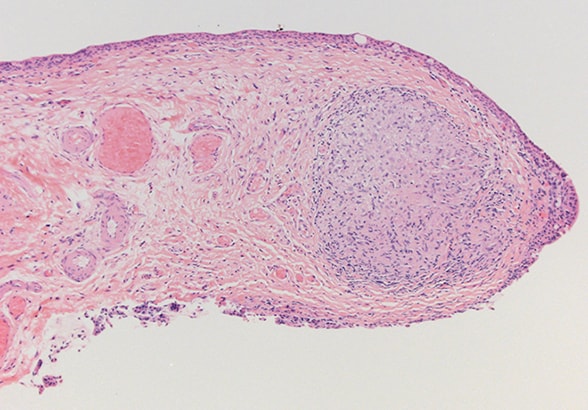April 13, 2018
非坏死性上皮样肉芽肿

非坏死性上皮样肉芽肿
结膜活检的 H 和 E 染色显示非坏死性上皮样肉芽肿。
The reported incidence of sarcoidosis — a chronic granulomatous disease of unknown etiology characterized by the presence of nonnecrotizing granulomata — varies from 6 to 70 per 100,000 people per year. Sarcoidosis typically affects the lungs and hilar lymph nodes, although any organ system may be affected, which may pose a diagnostic challenge.
Ocular involvement is a well-recognized extrathoracic complication of systemic sarcoidosis. The reported prevalence of ocular disease among patients with systemic sarcoidosis varies from 12 to 50 percent. Uveitis is the most common ocular disease, although any eye structure may be affected.
Wendy M. Smith, M.D., and a research team with Ophthalmology and Rheumatology at Mayo Clinic's campus in Rochester, Minnesota, studied a population-based cohort to develop comprehensive data on the clinical characteristics of ocular involvement of sarcoidosis.
"Most of the available studies are referral based, which may potentially capture only more-severe cases and not represent the true spectrum of the disease in the community," says Dr. Smith. "The objective of this study was to describe the epidemiology of ocular sarcoidosis, with an emphasis on clinical characteristics, in a geographically well-defined population of patients." Study findings were published online in Ocular Immunology and Inflammation in 2017.
Rochester Epidemiology Project
The population of Olmsted County, Minnesota, as documented in the Rochester Epidemiology Project, allowed a virtually complete ascertainment of all clinically recognized cases of ocular sarcoidosis among the residents of Olmsted County, Minnesota. The population is predominantly Northern European, although it has become increasingly more diverse.
The researchers used Rochester Epidemiology Project data to identify an inception cohort of patients with systemic sarcoidosis from 1976 to 2013, based on comprehensive individual medical records review. They then reviewed those medical records for ocular involvement, using a standardized data extraction form to record the following information:
- Age at diagnosis
- Sex
- Ethnicity
- Duration of follow-up
- Type of ocular involvement, which included scleritis, episcleritis, conjunctivitis, conjunctival nodule, uveitis, optic neuritis, orbital pseudotumor, eyelid lesion and lacrimal gland disease
- Ophthalmological presentations
- Laterality
- Visual acuity at diagnosis and at last follow-up
- Angiotensin-converting enzyme (ACE) level and serum calcium level at diagnosis
- Treatment and response to treatment
Researchers identified a total of 345 patients with incident cases of systemic sarcoidosis. Ocular involvement occurred in 23 of those patients (7 percent). The most common ocular disease was uveitis (61 percent), followed by dry eye disease, conjunctival nodule, episcleritis, anterior scleritis and conjunctivitis. Anterior uveitis was the most common type of uveitis (71 percent). The visual outcome of uveitis was favorable: Only one patient lost three or more lines of visual acuity during follow-up and had visual acuity of less than 20/200 at last visit.
Only 151 (44 percent) of the 345 patients with systemic sarcoidosis had at least one ophthalmic examination. Ocular involvement was identified in 15 percent of those patients. Dr. Smith notes: "It is possible there was a selection bias, since patients with eye complaints are more likely to be referred for ophthalmic evaluation and probably more likely to have ocular involvement. The true frequency of ocular involvement is probably somewhere between 7 and 15 percent."
Among this predominantly Caucasian cohort of patients with sarcoidosis, eye symptoms were the first presentation that led to the diagnosis of systemic sarcoidosis in more than half of the patients with uveitis. "This finding highlights the importance of the ophthalmological assessment in the diagnosis of this systemic disorder," says Dr. Smith.
For more information
Ungprasert P, et al. Clinical characteristics of ocular sarcoidosis: A population-based study 1976-2013. Ocular Immunology and Inflammation. In press.
Rochester Epidemiology Project